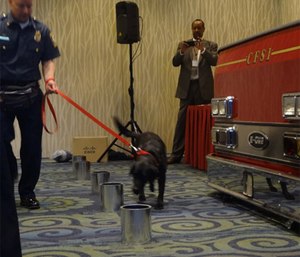
A long-running grant program is one option for adding a K-9 arson tool to fire or police agencies
One reason arson is such a hard crime to land a conviction for is a lack of evidence. And the reason for that is twofold: Fire does a very good job of destroying evidence, as do firefighters in their efforts to affect rescues and strike the fire.
To the best of their abilities, fire investigators will record images from the scene, take witness statements, clear the debris to look for the point of origin and fire path, and collect samples for lab testing. Yet, the national average conviction rate for arson is a paltry 10%.
One way to significantly boost the likelihood of a conviction is using K-9s trained to detect the presence of accelerants. But owning and operating such a K-9 is an expensive and complicated proposition.
To explain that process in greater detail, two experts made an hour-long presentation at the Congressional Fire Service's annual symposium, complete with a K-9 demonstration. The presentation coincided with National Arson Awareness Week.
"Having an accelerant-detection K-9 levels the playing field," said Heather Paul, who works on State Farm's Arson Dog Program. "The prosecution rate goes up significantly when an arson dog points to accelerants."
Since 1993, State Farm has been giving fire and police agencies grants to establish arson dog teams. The company has funded more than 360 teams so far at about $25,000 per team.
The dogs, Labradors or Labrador-Golden Retriever mixes, are either rescued from shelters or are dropouts from other work programs like assisting those with disabilities. They have to be high-energy and good with people, as they will spend much of their time doing fire prevention work at schools and public events.
"We want that dog to be excited to work," Paul said.
To be selected for the grant, agencies have to meet several criteria and may even go on a waiting list for several years. Among the criteria is a minimum of 50 structure fires per year; volunteer fire departments and private investigators are excluded. However, several departments, say within a county, can apply if the team will be shared across the region.
"It takes a special person to be part of this program," Paul said. "It's not for everyone."
Once awarded the grant, Paul Gallagher pairs the handler with a dog based on the dog's traits and the handler's living situation. Gallagher owns Maine Specialty Dogs and is a retired police officer.
All of the new teams go through 200 hours of training at Gallagher's facility in Maine. The dogs also go through an annual recertification process.
The courts place more value on evidence when the dog and the trainer are certified, Gallagher said. In the recertification process, the dogs are tested on blind samples sent by an outside lab — neither Gallagher or the handler knows which samples are hot. A dog is only allowed two errors before being removed from the program.
In addition to detecting accelerant samples on scene, which are sent to a lab for confirmation, arson dogs have also picked the arsonists out of crowds if they have traces of the accelerant on their bodies or clothes. They've also extracted confessions by simply being on scene, Paul said.
One of the myths about arson dogs is that their work leads to injury and cancer. Gallagher said that while it is up to the handler to decide scene safety, most dogs are injured at home — they live with their handlers during their service and through retirement.
They did experiment with putting boots on the dogs during investigations, he said, but that led to the dogs focusing more on what was on their feet than on sniffing out accelerants.
The dogs are not any more susceptible to cancer than other dogs, he said. Their average life span is 15 years.
The dogs can work 10 to 12 years, but are pulled out of service when they begin to show signs of slowing. It is important to let the dog enjoy some years of retirement, Paul said.
And at present, there's no signs of these K-9s being replaced by machines.
Try as they might, scientists have not figured out a way to replicate the accuracy of the arson dog's nose, Gallagher said. "We don't know how they do it."
Copyright © 2024 FireGrantsHelp.com. All rights reserved.
